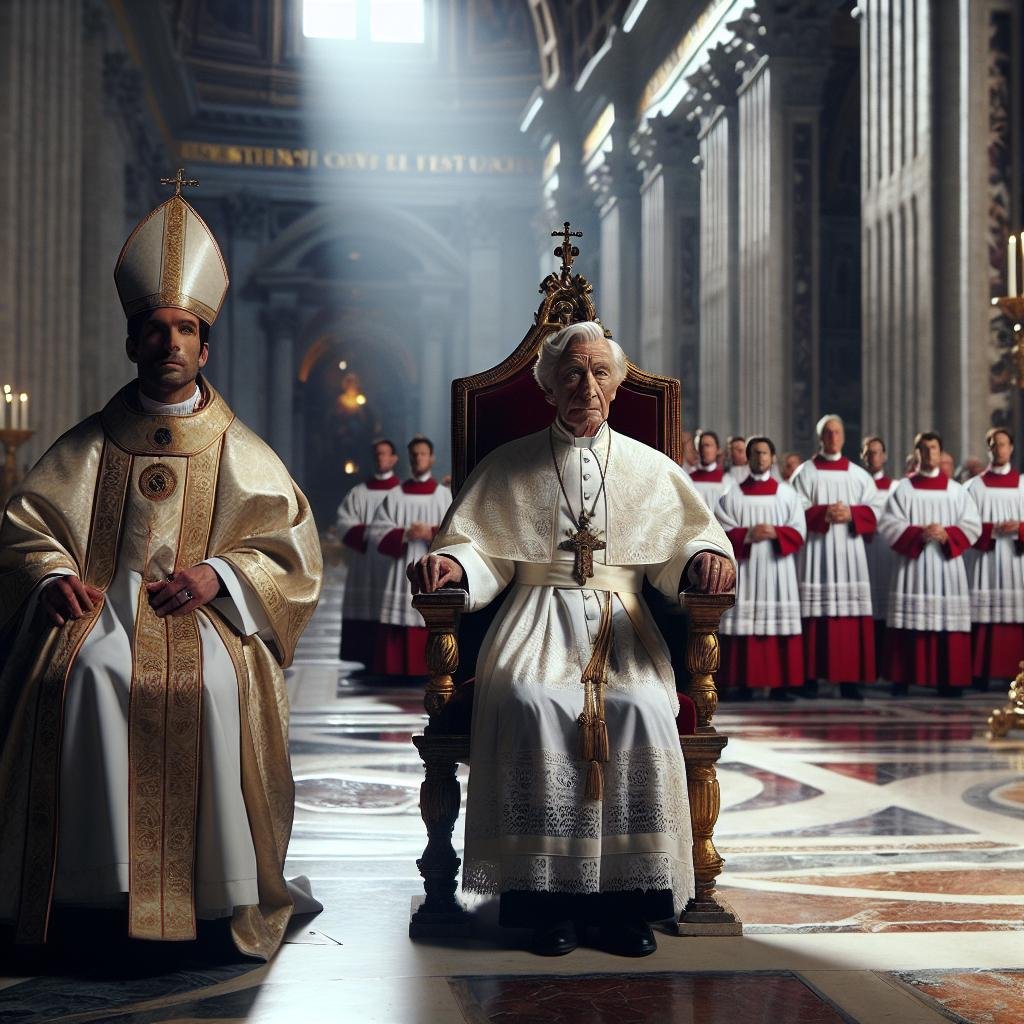
Church Digital Revolution | Essential Guide from Pope Leo XIV
Pope Leo XIV addressed the College of Cardinals on May 10, 2025, urging the Catholic Church to adapt to the digital age while maintaining its spiritual identity. During his landmark speech at the Vatican, the Pope outlined concrete steps for parishes worldwide to integrate technology while preserving human connections. “The digital revolution represents both opportunity and challenge for our faithful,” stated Pope Leo XIV, emphasizing the need for balance between innovation and tradition.
Pope’s Call for Digital Transformation
Pope Leo XIV’s address marks a significant shift in the Church’s approach to modern communication platforms. Speaking to the assembled cardinals, the pontiff acknowledged how digital tools have fundamentally altered how people connect, learn, and practice their faith.
“We cannot remain anchored solely to methods of the past,” the Pope said. “Yet we must ensure that technology serves our mission rather than reshaping it according to secular values.”
The Pope’s vision includes developing a comprehensive digital strategy for the Church that respects its two-thousand-year tradition while embracing new ways to reach believers, especially younger generations who primarily communicate through digital channels.
Key Points from the Pope’s Address
The Holy Father identified several areas requiring immediate attention from Church leadership:
- Formation of priests and religious in digital literacy
- Development of virtual prayer communities that complement physical gatherings
- Guidelines for maintaining the sanctity of sacraments in digital contexts
- Protection of vulnerable online users, particularly children
- Ethical framework for artificial intelligence aligned with Catholic teachings
Cardinal Giovanni Rossi, prefect of the newly established Dicastery for Digital Evangelization, commented after the address: “The Pope has given us a clear mandate to engage with the digital world not as passive observers but as active participants shaping its development.”
Balancing Virtual and Physical Community
A central theme in Pope Leo’s address was the importance of maintaining authentic human connections in an increasingly virtual world. He warned against digital experiences replacing physical gatherings of the faithful.
“The Eucharist cannot be digitized,” the Pope stated firmly. “While we embrace new methods of outreach, we must remember that our faith is incarnational—it demands physical presence and communion.”
This statement reflects ongoing discussions within the Church about the limits of virtual religious experiences, particularly after the COVID-19 pandemic forced many parishes to adopt online Masses and prayer services.
The Pope called for dioceses to develop frameworks that use digital tools to enhance rather than replace in-person worship. He suggested models where online engagement serves as a pathway to physical participation in parish life.
Digital Ethics and Catholic Teaching
Pope Leo devoted significant attention to the ethical dimensions of technology. He expressed concern about the “digital divide” that excludes poorer communities from technological benefits.
“Access to digital resources has become a new form of wealth distribution,” the Pope noted. “The Church must advocate for equitable access while helping all people navigate these tools with wisdom.”
He also addressed the rapid development of artificial intelligence, calling for Catholic ethicists to participate actively in global conversations about AI governance. The Pope warned against allowing profit-driven enterprises to determine alone how these technologies develop.
“Algorithms must serve human flourishing, not merely economic interests,” he insisted. “The Church brings a vital perspective to these discussions—one that places human dignity at the center.”
This ethical framework builds upon the Rome Call for AI Ethics, initiated under Pope Francis, which promotes a human-centered approach to artificial intelligence development.
Real-World Example
The Pope highlighted the success of the Diocese of Lyon, France, which created a “digital missionary team” consisting of tech-savvy young adults who help elderly parishioners navigate online resources. This initiative not only bridges the technological gap but also fosters intergenerational relationships.
“In Lyon, an 85-year-old woman named Marie can now join daily prayer via her tablet,” the Pope shared with a warm smile. “She says her digital angels—as she calls the young volunteers—have opened a new world to her without replacing her Sunday Mass attendance. This is the harmony we seek.”
Practical Steps for Parishes
Beyond philosophical guidance, Pope Leo XIV outlined concrete actions for implementing his vision at the parish level:
- Establish digital ministry teams in each parish
- Provide technology access points in church facilities for those without personal devices
- Develop content that respects attention spans while maintaining doctrinal depth
- Train clergy in effective online communication
- Create safeguarding protocols for all digital interactions
Cardinal Miguel Suarez from Mexico City commented: “These practical guidelines will help parishes that feel overwhelmed by technological change. Many priests want to engage digitally but don’t know where to begin.”
The Pope encouraged bishops to allocate resources specifically for digital ministry, suggesting that such investments should be viewed as essential rather than optional in modern evangelization efforts.
Formation in the Digital Age
A significant portion of the Pope’s address focused on formation—both for clergy and laity. He announced plans for a revised seminary curriculum that includes digital literacy alongside traditional theological training.
“Tomorrow’s priests must understand both Aquinas and algorithms,” Pope Leo remarked. “They need not become technical experts, but they must comprehend how digital environments shape human thinking and behavior.”
For the laity, the Pope called for development of resources that help families navigate digital challenges, particularly regarding children’s screen time and exposure to online content. He referenced the Catholic Digital Family Plan as a model worth expanding.
“Parents need Church support as they guide children through digital landscapes filled with both opportunities and dangers,” the Pope said. “We must equip them with wisdom rooted in our tradition yet applicable to these new territories.”
Global Digital Solidarity
Pope Leo emphasized that the Church’s digital strategy must include global solidarity, ensuring that technological resources reach communities regardless of economic status.
“Digital evangelization cannot be limited to wealthy nations,” he stated. “The universal Church must develop models that work in diverse settings, from metropolitan centers to remote villages.”
He announced the creation of a Digital Solidarity Fund to support technology access in economically disadvantaged dioceses. The fund will provide both equipment and training to ensure effective implementation.
Archbishop Thomas Ojuka from Uganda responded positively: “This fund acknowledges that the digital revolution must include all believers. In rural Africa, even basic internet access can transform how we serve our communities.”
Preserving Contemplation in a Connected World
While embracing digital tools, Pope Leo XIV also stressed the importance of preserving spaces for silence, reflection, and contemplation.
“Our increasingly connected world often lacks moments of genuine interior quiet,” the Pope observed. “The Church must continue offering oases of silence where people can hear God’s voice amid digital noise.”
He suggested that parishes could provide “digital detox” retreats and prayer experiences that help believers develop healthy boundaries with technology. The Pope noted that monastic traditions offer valuable wisdom for maintaining spiritual focus in distracting environments.
“The desert fathers withdrew from distraction to find God,” he remarked. “Today’s ‘desert’ might include turning off notifications rather than traveling to remote locations—yet the spiritual principle remains the same.”
Historical Context of Church and Technology
The Pope placed his digital initiative in historical context, noting that the Church has repeatedly adapted to communication revolutions throughout history.
“From the printing press to radio and television, the Church has learned to speak through new media while preserving its essential message,” Pope Leo said. “Digital transformation represents another such moment—perhaps more profound, but not without precedent.”
He cited how early Christians adapted Greek philosophical concepts to express theological truths, suggesting that today’s believers must likewise learn the “language” of digital culture to effectively communicate the Gospel.
Church historian Dr. Sofia Bianchi notes: “Pope Leo’s approach follows a pattern we’ve seen throughout Church history—initial caution followed by thoughtful engagement with new communication methods. His balance between enthusiasm and prudence reflects this tradition.”
Next Steps and Implementation
Concluding his address, Pope Leo XIV announced the formation of a special commission to develop detailed guidelines for implementing his digital vision. The commission will include bishops, theologians, media experts, and tech professionals.
“This work requires many voices and perspectives,” the Pope explained. “We need both the wisdom of tradition and the insights of those who understand digital culture firsthand.”
The commission will present initial recommendations at the next Synod of Bishops, scheduled for October 2025. These guidelines will then be adapted for regional and local implementation.
Cardinal Robert Chen from Taiwan, appointed to lead the commission, stated: “The Holy Father has given us a mandate that respects both unity and diversity. Our guidelines will provide a common framework while allowing for cultural adaptation.”
Reactions from Church Leadership
Reactions from the College of Cardinals reflected broad support for the Pope’s initiative, though with varying emphases reflecting regional concerns.
Cardinal Francis O’Malley from Boston highlighted youth engagement: “Young Catholics live digital lives. If we’re not present in those spaces with authentic witness, others will fill the void with messages contrary to faith.”
Meanwhile, Cardinal Paul Mbeki from South Africa stressed accessibility: “As we embrace digital tools, we must ensure they don’t create new barriers. Many faithful have limited internet access or digital skills—they cannot be left behind.”
Several cardinals also noted that the Pope’s message acknowledged legitimate concerns about technology while avoiding simplistic rejection of digital culture.
Conclusion: A Faith That Embraces the Future
Pope Leo XIV’s address represents a significant moment in the Church’s relationship with digital culture—neither uncritical embrace nor fearful rejection, but thoughtful engagement guided by Catholic principles.
“The digital revolution, like all human developments, contains both promise and peril,” the Pope concluded. “Our task is to discern how these new tools can serve the eternal mission entrusted to us by Christ—to proclaim the Gospel to all creation.”
This balanced approach acknowledges both the opportunities for evangelization and the challenges to human dignity presented by digital transformation. As the Church implements the Pope’s vision over coming years, it will continue its centuries-old tradition of engaging with cultural changes while maintaining its essential identity and mission.
Have thoughts about how the Church should respond to digital culture? We’d love to hear your perspective in the comments below.


